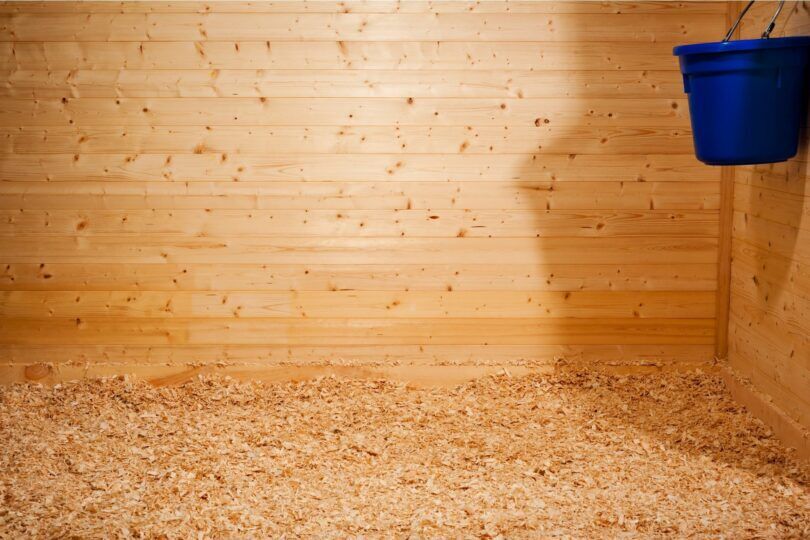Bedding Tips for Horse Stalls
As horse lovers, it is our biggest priority to keep our horses as comfortable as possible. For horses that are kept in indoor stalls, shavings provide somewhere soft for the horse to lay down—and shavings absorb urine too. Horses that are stalled may have dirt underneath shavings, or they may have rubber mats laid down as a base.
There are several types of shavings available as bedding in a horse stall. It is helpful to understand the different types of shavings available in your area so you can decide what will work best for your horse. To figure out how much bedding is needed, you’ll need to do some math and know how frequently the stall is cleaned. Generally, more frequent cleaning means less shavings needed!
Stall Bedding Basics
Horse stalls need bedding for multiple reasons. Not only do you want the proper amount of bedding to keep the horse comfortable, bedding also helps to absorb urine and keeps ammonia odors at bay.
There are a few types of bedding that are popular to use for horse stalls. Shavings are perhaps the most commonly used type of bedding. They are made out of finely shaved wood pieces such as pine or cedar.
Shavings are common because they are easy to find, extremely absorbent, and tend to be very soft for the horse to lay on.
Some horse owners will choose to use straw as their choice of bedding. Straw is usually reasonably priced and easy to find as well. The disadvantages of straw include that it is typically dusty and can be susceptible to mold.
Pelleted bedding has become very popular to use for horse stalls as well. The bedding comes in small wood pellets and must be wet in order to break down the pellets. Once broken down, they create a very absorbent and soft material for the horse to lay down on.
People will sometimes choose pellets because they are up to four times more absorbent than other types of bedding.
| Bedding Type | Pros | Cons |
| Shavings |
|
|
| Straw |
|
|
| Wood Pellets |
|
|
Stall Cleaning 101
An important part of keeping your horse healthy and comfortable is cleaning its stall. Stalls should be cleaned every day. If you are able, you can clean the stall multiple times a day to make the task easy and quick.
You do not want your horse laying in their own urine or manure. Infrequent cleaning combined with poor ventilation can also cause a buildup of ammonia and subsequent respiratory illnesses.
A horse’s stall is best cleaned by using a manure fork. You can easily scoop the manure out of the stall regardless of the bedding choice you have chosen. Along with scooping the manure, you need to remove any urine-soaked bedding as well.
Photo Cred: Canva
If you have heard of the term “stripping a stall,” you might be wondering what it means. Stripping a horse’s stall means you are completely cleaning out every bit of bedding from the stall. This can be done intermittently.
Some people will choose to do this once a month to ensure the stall is completely clean, check the flooring underneath, and then replace shavings in the stall with completely fresh bedding.
Stall Bedding Math
It can be tricky to determine how much bedding your horse’s stall needs. Typically, most horse stalls will need about 8”-10” of bedding. If the flooring is soft underneath your horse, then it might be slightly less.
For example, if you’re bedding down a 12’x12’ stall that has been stripped, you’d want to add four to five (8) cubic foot bags of shavings.
If there are already shavings in the stall, you may only need to add one bag to replenish what was lost from the day’s cleaning.
Photo Cred: Canva
Frequently Asked Questions
Q: Are cedar shavings safe for horses?
Although cedar shavings smell great, they do have a high oil content. This can be irritating to a horse’s skin and cause allergic reactions.
Some people do choose to use the cedar shavings without issue, but it is important to be aware of the problems it can cause.
Q: What type of bedding should you use when your mare is giving birth?
Although shavings tend to be the most popular bedding choice, straw is an excellent option for a mare giving birth. This ensures that the shavings will not stick to the newly born foal.
Q: Are horses allergic to certain types of stall bedding?
Horses can have allergic reactions to certain types of stall bedding. Cedar shavings can cause issues for some horses’ skin. Straw can potentially pose a problem, as well, due to the high dust content.
This can cause respiratory and allergy issues in horses if they are exposed to a large amount of dust frequently.
Q: Do stalls need stall mats?
Technically no, stalls do not need mats. However, mats can help maintain a level surface (some horses like to paw; if the floor is dirt they may dig holes in it).
Mats also make stall cleaning faster and more efficient. While they can be expensive, stall mats last a long time and will save you money on bedding in the long run!
P.S. Enjoy this article? Trot on over to:
- Down ‘n Dirty Horse Barn Cleaning Tips
- Horse Boarding 101 (What it Costs, Types, FAQs)
- Buh-Bye Buckets: 5 Best Automatic Horse Waterers
- Wild & Hair Free: What is Horse Body Clipping?
- Winter Hay 101: How Much to Feed Your Horse (And Why)
- Horse Hay FAQs: List of Types of Hay, What Hay is Best, etc.
- Horse Lifespan 101 (Life Stages, Teeth, Senior Horse Care)
